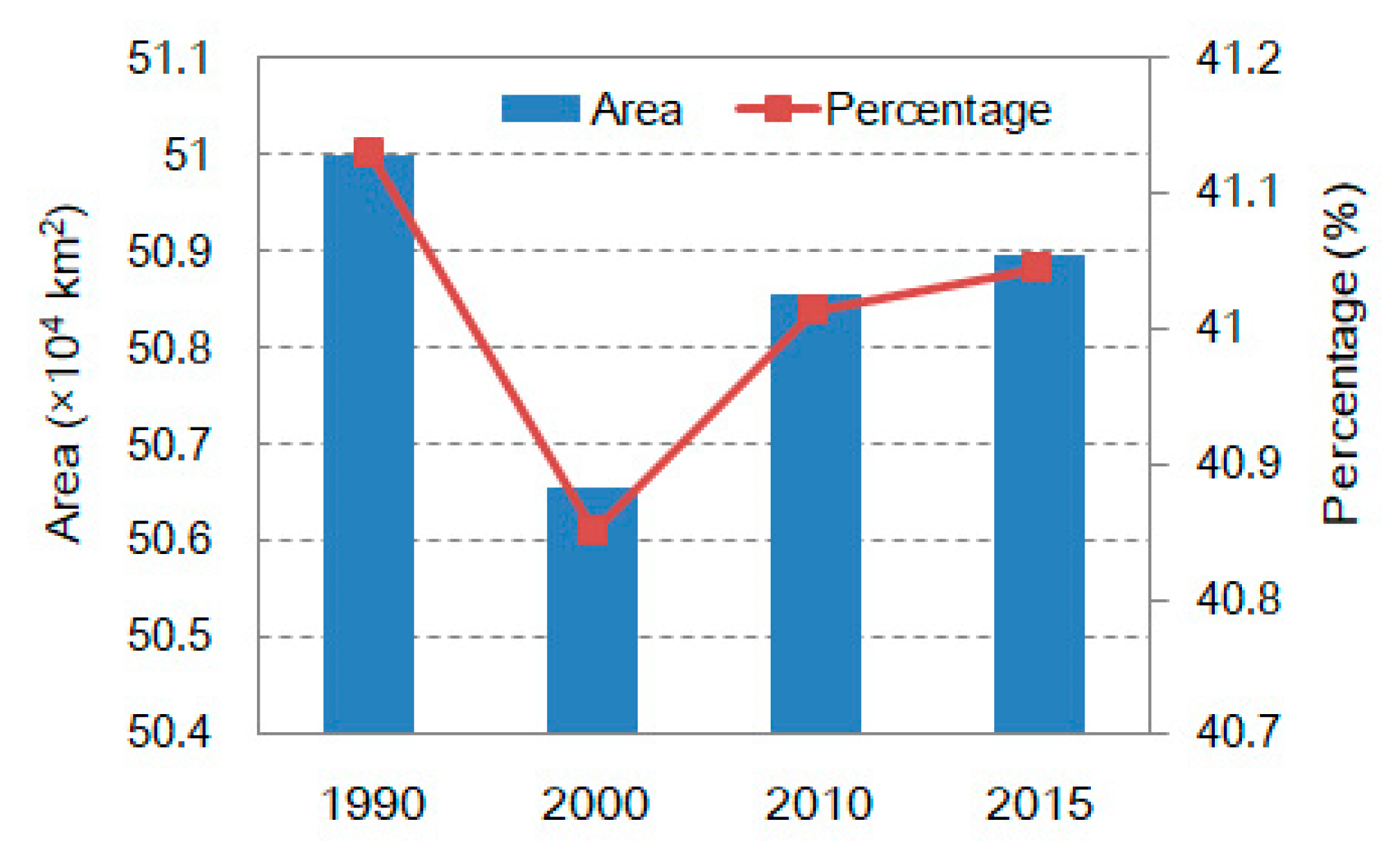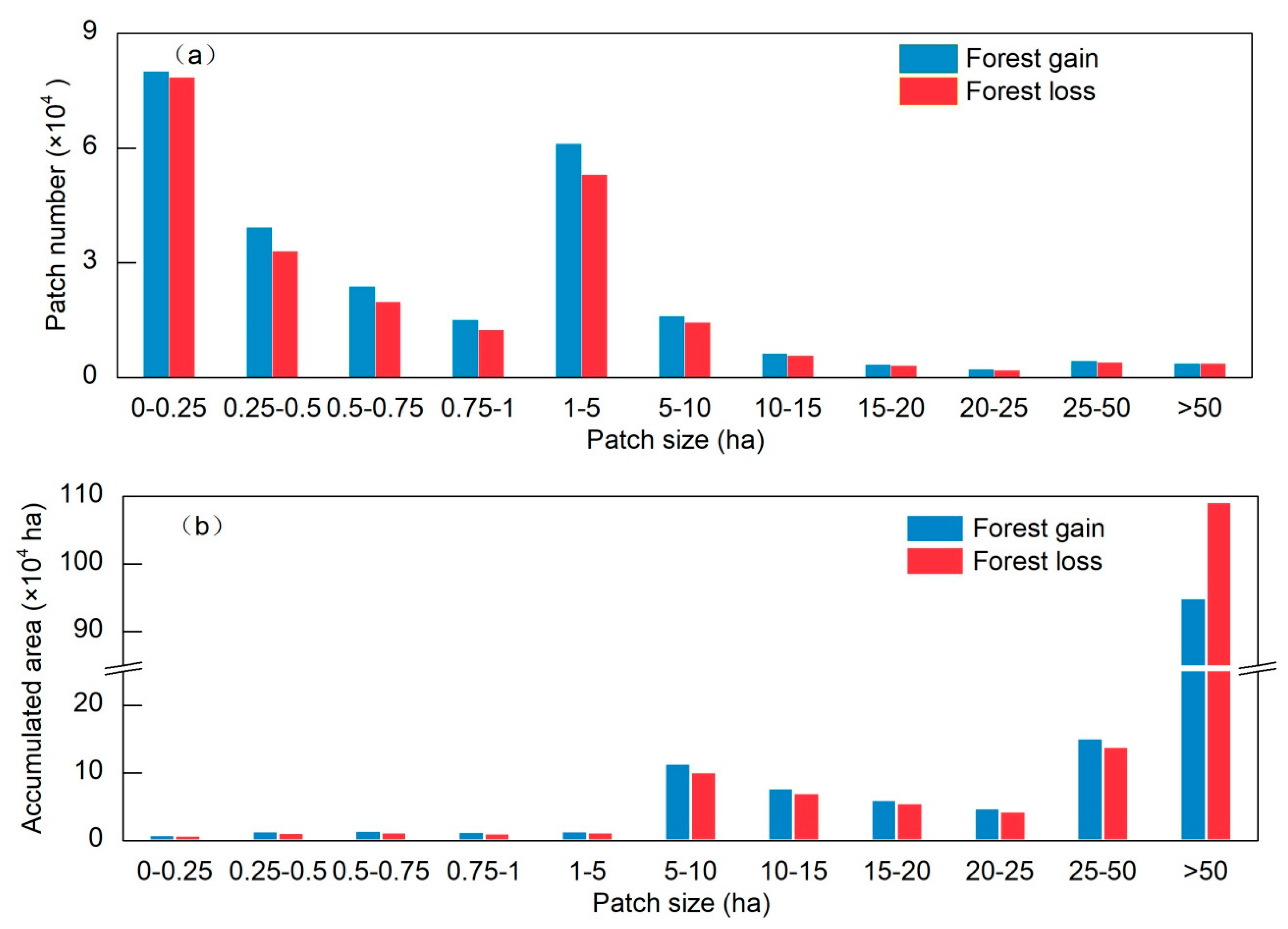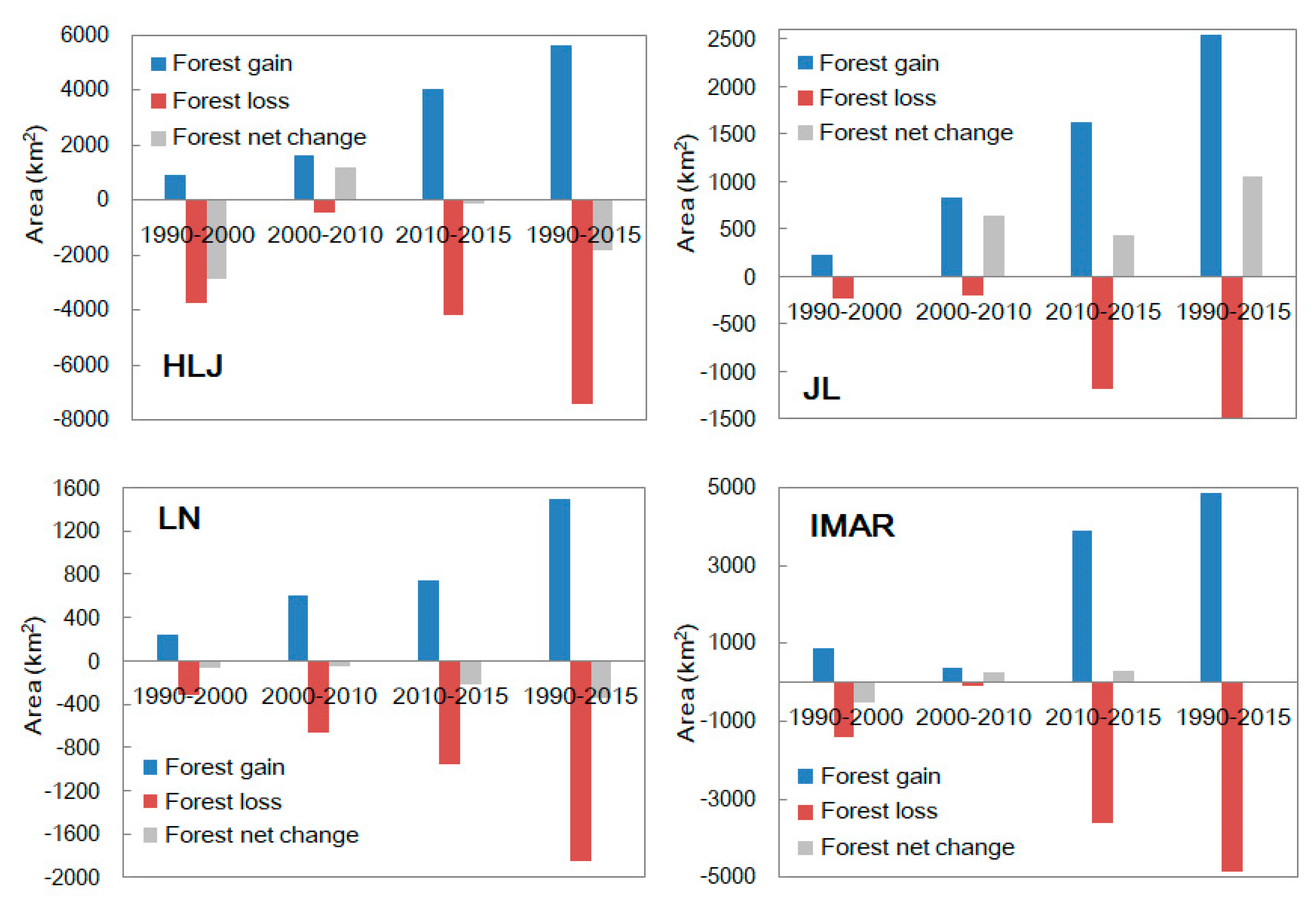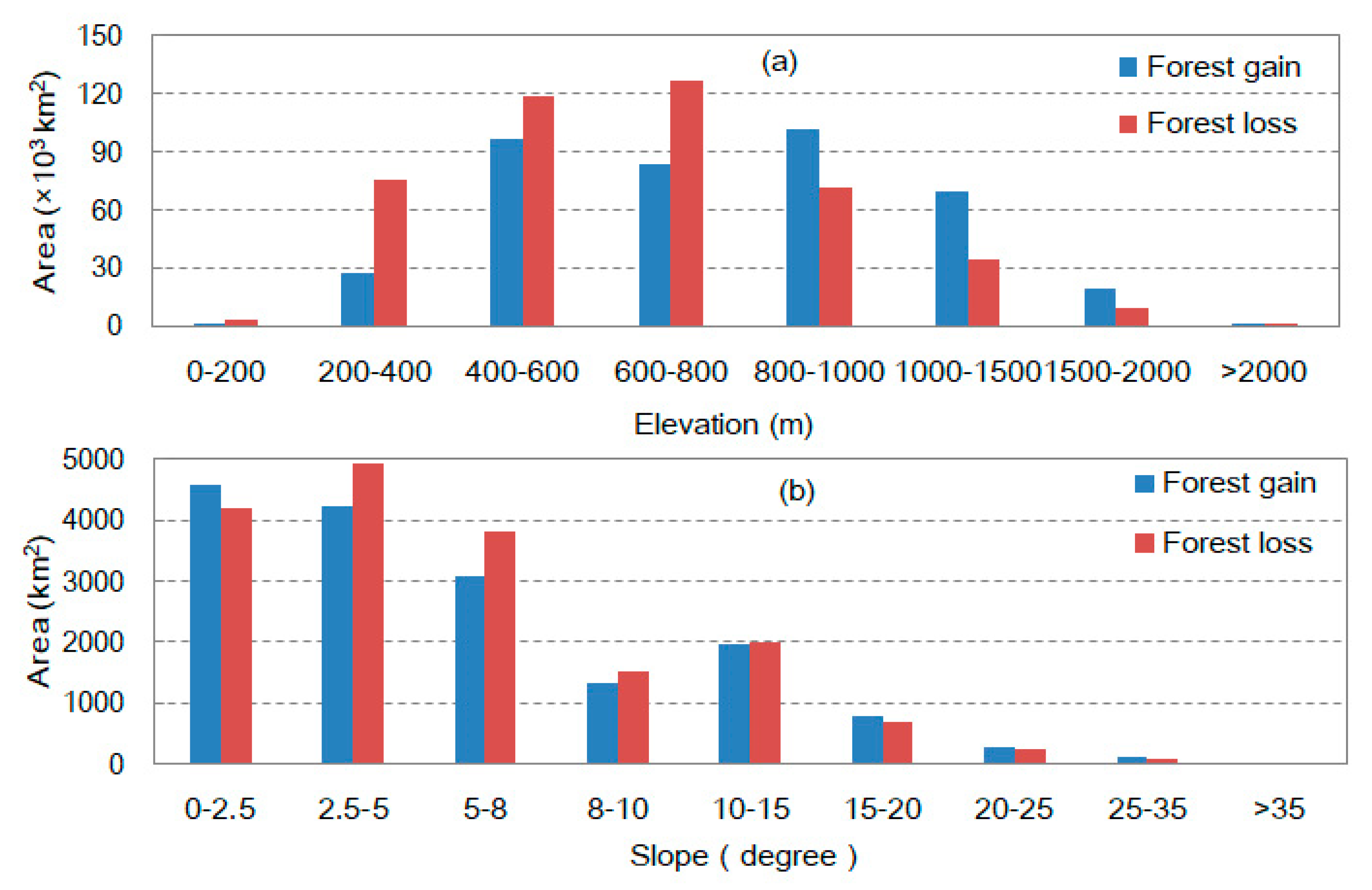Spatio–Temporal Changes of Forests in Northeast China: Insights from Landsat Images and Geospatial Analysis
Abstract
1. Introduction
2. Materials and Methods
2.1. Study Area
2.2. Landsat Imagery
2.3. Forest Mapping with an Updating and Object-Based Image Analysis (OBIA) Approach
2.4. Data Analysis
3. Results
3.1. Accuracy Assessment
3.2. Spatial and Temporal Changes of Forests in Northeast China
3.3. Geospatial Variation of Forest Changes in Northeast China
4. Discussion
4.1. Forest Dynamics and Potential Drivers in Northeast China
4.2. The Uncertainty of Forest Mapping with Remote Sensing
4.3. Limitations and Future Work
5. Conclusions
Author Contributions
Funding
Acknowledgments
Conflicts of Interest
References
- FAO. The State of the World’s Forests_Forest Pathways to Sustainable Development; FAO: Rome, Italy, 2018. [Google Scholar]
- Foley, J.; DeFries, R.; Asner, G.; Barford, C.; Bonan, G.; Carpenter, S.R.; Chapin, F.S.; Coe, M.T.; Daily, G.C.; Gibbs, H.K.; et al. Global consequences of land use. Science 2005, 309, 570–574. [Google Scholar] [CrossRef] [PubMed]
- Hansen, M.; Potapov, P.; Moore, R.; Hancher, M.; Turubanova, S.; Tyukavina, A.; Thau, D.; Stehman, S.V.; Goetz, S.J.; Loveland, T.R.; et al. High-resolution global maps of 21st-century forest cover change. Science 2013, 342, 850–853. [Google Scholar] [CrossRef] [PubMed]
- Qin, Y.; Xiao, X.; Dong, J.; Zhou, Y.; Wang, J.; Doughty, R.B.; Chen, Y.; Zou, Z.; Moore, B. Annual dynamics of forest areas in south america during 2007–2010 at 50-m spatial resolution. Remote Sens. Environ. 2017, 201, 73–87. [Google Scholar] [CrossRef]
- Qin, Y.; Xiao, X.; Wang, J.; Dong, J.; Ewing, K.; Hoagland, B.; Hough, D.; Fagin, T.; Zou, Z.; Geissler, G.; et al. Mapping annual forest cover in sub-humid and semi-arid regions through analysis of landsat and palsar imagery. Remote Sens. 2016, 8, 933. [Google Scholar] [CrossRef]
- Chen, B.Q.; Li, X.P.; Xiao, X.M.; Zhao, B.; Dong, J.W.; Kou, W.L.; Qin, Y.W.; Yang, C.; Wu, Z.X.; Sun, R.; et al. Mapping tropical forests and deciduous rubber plantations in hainan island, china by integrating palsar 25-m and multi-temporal landsat images. Int. J. Appl. Earth Obs. Geoinf. 2016, 50, 117–130. [Google Scholar] [CrossRef]
- Ren, C.; Zhang, B.; Wang, Z.; Li, L.; Jia, M. Mapping forest cover in northeast china from chinese hj-1 satellite data using an object-based algorithm. Sensors 2018, 18, 4452. [Google Scholar] [CrossRef]
- Huang, W. Forest condition change, tenure reform, and government-funded eco-environmental programs in northeast china. Forest Policy Econ. 2019, 98, 67–74. [Google Scholar] [CrossRef]
- Yu, D.; Zhou, L.; Zhou, W.; Ding, H.; Wang, Q.; Wang, Y.; Wu, X.; Dai, L. Forest management in northeast china: History, problems, and challenges. Environ. Manag. 2011, 48, 1122–1135. [Google Scholar] [CrossRef]
- Hyde, W.F.; Yin, R. 40 years of china’s forest reforms: Summary and outlook. Forest Policy Econ. 2019, 98, 90–95. [Google Scholar] [CrossRef]
- Ren, Y.; Lü, Y.; Fu, B.; Zhang, K. Biodiversity and ecosystem functional enhancement by forest restoration: A meta-analysis in china. Land Degrad. Dev. 2017, 28, 2062–2073. [Google Scholar] [CrossRef]
- Andrés Viña, W.J.M.; Yang, H.; Xu, Z.; Liu, J. Effects of conservation policy on china‘s forest recovery. Sci. Adv. 2016, 2, e1500965. [Google Scholar] [CrossRef] [PubMed]
- José Vidal-Macua, J.; Ninyerola, M.; Zabala, A.; Domingo-Marimon, C.; Pons, X. Factors affecting forest dynamics in the iberian peninsula from 1987 to 2012. The role of topography and drought. For. Ecol. Manag. 2017, 406, 290–306. [Google Scholar] [CrossRef]
- Qin, Y.; Xiao, X.; Dong, J.; Zhang, G.; Shimada, M.; Liu, J.; Li, C.; Kou, W.; Moore, B. Forest cover maps of china in 2010 from multiple approaches and data sources: Palsar, landsat, modis, fra, and nfi. ISPRS J. Photogramm. 2015, 109, 1–16. [Google Scholar] [CrossRef]
- Chen, B.; Xiao, X.; Ye, H.; Ma, J.; Doughty, R.; Li, X.; Zhao, B.; Wu, Z.; Sun, R.; Dong, J.; et al. Mapping forest and their spatial–temporal changes from 2007 to 2015 in tropical hainan island by integrating alos/alos-2 l-band sar and landsat optical images. IEEE J-STARS 2018, 11, 852–867. [Google Scholar] [CrossRef]
- Dong, J.; Xiao, X.; Sheldon, S.; Biradar, C.; Duong, N.D.; Hazarika, M. A comparison of forest cover maps in mainland southeast asia from multiple sources: Palsar, meris, modis and fra. Remote Sens. Environ. 2012, 127, 60–73. [Google Scholar] [CrossRef]
- Wang, J.; Xiao, X.; Qin, Y.; Doughty, R.B.; Dong, J.; Zou, Z. Characterizing the encroachment of juniper forests into sub-humid and semi-arid prairies from 1984 to 2010 using palsar and landsat data. Remote Sens. Environ. 2018, 205, 166–179. [Google Scholar] [CrossRef]
- Xu, W.; Qin, Y.; Xiao, X.; Di, G.; Doughty, R.B.; Zhou, Y.; Zou, Z.; Kong, L.; Niu, Q.; Kou, W. Quantifying spatial-temporal changes of tea plantations in complex landscapes through integrative analyses of optical and microwave imagery. Int. J. Appl. Earth Obs. Geoinf. 2018, 73, 697–711. [Google Scholar] [CrossRef]
- Shimada, M.; Itoh, T.; Motooka, T.; Watanabe, M.; Shiraishi, T.; Thapa, R.; Lucas, R. New global forest/non-forest maps from alos palsar data (2007–2010). Remote Sens. Environ. 2014, 155, 13–31. [Google Scholar] [CrossRef]
- Broich, M.; Hansen, M.C.; Potapov, P.; Adusei, B.; Lindquist, E.; Stehman, S.V. Time-series analysis of multi-resolution optical imagery for quantifying forest cover loss in sumatra and kalimantan, indonesia. Int. J. Appl. Earth Obs. Geoinf. 2011, 13, 277–291. [Google Scholar] [CrossRef]
- Gong, P.; Wang, J.; Yu, L.; Zhao, Y.; Zhao, Y.; Liang, L.; Niu, Z.; Huang, X.; Fu, H.; Liu, S.; et al. Finer resolution observation and monitoring of global land cover: First mapping results with landsat TM and ETM+ data. Int. J. Remote Sens. 2013, 34, 2607–2654. [Google Scholar] [CrossRef]
- Chen, J.; Chen, J.; Liao, A.; Cao, X.; Chen, L.; Chen, X.; He, C.; Han, G.; Peng, S.; Lu, M.; et al. Global land cover mapping at 30m resolution: A pok-based operational approach. ISPRS J. Photogramm. 2015, 103, 7–27. [Google Scholar] [CrossRef]
- Tyukavina, A.; Hansen, M.; Potapov, P.; Parker, D.; Okpa, C.; Stehman, S.; Kommareddy, I.; Turubanova, S. Congo basin forest loss dominated by increasing smallholder clearing. Sci. Adv. 2018, 4, eaat2993. [Google Scholar] [CrossRef] [PubMed]
- Wang, J.; Xiao, X.; Qin, Y.; Dong, J.; Geissler, G.; Zhang, G.; Cejda, N.; Alikhani, B.; Doughty, R.B. Mapping the dynamics of eastern redcedar encroachment into grasslands during 1984–2010 through palsar and time series landsat images. Remote Sens. Environ. 2017, 190, 233–246. [Google Scholar] [CrossRef]
- Acacio, V.; Dias, F.S.; Catry, F.X.; Rocha, M.; Moreira, F. Landscape dynamics in mediterranean oak forests under global change: Understanding the role of anthropogenic and environmental drivers across forest types. Glob. Chang. Biol. 2017, 23, 1199–1217. [Google Scholar] [CrossRef] [PubMed]
- Bello-Rodríguez, V.; García, C.; del-Arco, M.J.; Hernández-Hernández, R.; González-Mancebo, J.M. Spatial dynamics of expanding fragmented thermophilous forests on a macaronesian island. For. Ecol. Manag. 2016, 379, 165–172. [Google Scholar] [CrossRef]
- Freitas, S.R.; Hawbaker, T.J.; Metzger, J.P. Effects of roads, topography, and land use on forest cover dynamics in the brazilian atlantic forest. For. Ecol. Manag. 2010, 259, 410–417. [Google Scholar] [CrossRef]
- Taubert, F.; Fischer, R.; Groeneveld, J.; Lehmann, S.; Muller, M.S.; Rodig, E.; Wiegand, T.; Huth, A. Global patterns of tropical forest fragmentation. Nature 2018, 554, 519–522. [Google Scholar] [CrossRef]
- Zhou, Y.; Zu, Y. Geography of the Vegetation in Northeast China; Science Press: Beijing, China, 1997. [Google Scholar]
- Earth Resources Observation and Science (EROS) Data Center, USGS. Available online: https://glovis.usgs.gov/ (accessed on 5 January 2016).
- GISAT. Available online: http://gdem.ersdac.jspacesystems.or.jp/ (accessed on 1 July 2011).
- Pham, L.T.H.; Brabyn, L.; Ashraf, S. Combining quickbird, lidar, and gis topography indices to identify a single native tree species in a complex landscape using an object-based classification approach. Int. J. Appl. Earth Obs. Geoinf. 2016, 50, 187–197. [Google Scholar] [CrossRef]
- Mitchell, M.; Wilson, R.R.; Twedt, D.J.; Mini, A.E.; James, J.D. Object-based forest classification to facilitate landscape-scale conservation in the mississippi alluvial valley. Remote Sens. Appl. Soc. Environ. 2016, 4, 55–60. [Google Scholar] [CrossRef]
- Zhou, W.; Huang, G.; Pickett, S.T.A.; Cadenasso, M.L. 90 years of forest cover change in an urbanizing watershed: Spatial and temporal dynamics. Landscape Ecol. 2011, 26, 645–659. [Google Scholar] [CrossRef]
- Jin, S.; Yang, L.; Danielson, P.; Homer, C.; Fry, J.; Xian, G. A comprehensive change detection method for updating the national land cover database to circa 2011. Remote Sens. Environ. 2013, 132, 159–175. [Google Scholar] [CrossRef]
- Xian, G.; Homer, C. Updating the 2001 national land cover database impervious surface products to 2006 using landsat imagery change detection methods. Remote Sens. Environ. 2010, 114, 1676–1686. [Google Scholar] [CrossRef]
- Yu, W.; Zhou, W.; Qian, Y.; Yan, J. A new approach for land cover classification and change analysis: Integrating backdating and an object-based method. Remote Sens. Environ. 2016, 177, 37–47. [Google Scholar] [CrossRef]
- Yang, Z.; Dong, J.; Liu, J.; Zhai, J.; Kuang, W.; Zhao, G.; Shen, W.; Zhou, Y.; Qin, Y.; Xiao, A.X. Accuracy assessment and inter-comparison of eight medium resolution forest products on the loess plateau, China. ISPRS Int. J. Geo-Inf. 2017, 6, 152. [Google Scholar] [CrossRef]
- Zhang, L.; Li, X.; Yuan, Q.; Liu, Y. Object-based approach to national land cover mapping using hj satellite imagery. J. Appl. Remote Sens. 2014, 8, 083686. [Google Scholar] [CrossRef]
- Ouyang, Z.; Zheng, H.; Xiao, Y.; Polasky, S.; Liu, J. Improvements in ecosystem services from investigates in natural capital. Science 2016, 352, 1455–1459. [Google Scholar] [CrossRef]
- Mao, D.; Luo, L.; Wang, Z.; Wilson, M.C.; Zeng, Y.; Wu, B.; Wu, J. Conversions between natural wetlands and farmland in China: A multiscale geospatial analysis. Sci. Total Environ. 2018, 634, 550–560. [Google Scholar] [CrossRef]
- European Space Agency. Land Cover CCI Product User Guide Version 2.4; European Space Agency: Paris, France, 2016. [Google Scholar]
- Friedl, M.A.; Sulla-Menashe, D.; Tan, B.; Schneider, A.; Ramankutty, N.; Sibley, A.; Huang, X. Modis collection 5 global land cover: Algorithm refinements and characterization of new datasets. Remote Sens. Environ. 2010, 114, 168–182. [Google Scholar] [CrossRef]
- Liu, J.; Kuang, W.; Zhang, Z.; Xu, X.; Qin, Y.; Ning, J.; Zhou, W.; Zhang, S.; Li, R.; Yan, C.; et al. Spatiotemporal characteristics, patterns, and causes of land-use changes in China since the late 1980s. J. Geogr. Sci. 2014, 24, 195–210. [Google Scholar] [CrossRef]
- SFA. The 8th Forest Resources Inventory Results in China; SFA: Beijing, China, 2014. [Google Scholar]
- China Forestry Database. Available online: http://www.forestry.gov.cn/data.html (accessed on 25 February 2019).
- FAO. Global Forest Resources Assessment; FAO: Rome, Italy, 2015. [Google Scholar]
- Kuang, W.; Zhang, S.; Zhang, Y.; Li, Y.; Hou, W. Landscape and its driving mechanism during the last fifty years in the eastern mountain area of jilin province. J. Beijing For. Univ. 2006, 28, 38–45. [Google Scholar]
- Stanturf, J.A.; Palik, B.J.; Dumroese, R.K. Contemporary forest restoration: A review emphasizing function. For. Ecol. Manag. 2014, 331, 292–323. [Google Scholar] [CrossRef]
- DeFries, R.S.; Rudel, T.; Uriarte, M.; Hansen, M. Deforestation driven by urban population growth and agricultural trade in the twenty-first century. Nat. Geosci. 2010, 3, 178–181. [Google Scholar] [CrossRef]
- Ahrends, A.; Burgess, N.; Milledge, S.; Bulling, M.; Fisher, B.; Smart, J.C.; Clarke, G.P.; Mhoro, B.E.; Lewis, S.L. Predictable waves of sequential forest degradation and biodiversity loss spreading from an african city. Proc. Natl. Acad. Sci. USA 2010, 107, 14556–14561. [Google Scholar] [CrossRef] [PubMed]
- Liu, J.; Liu, M.; Tian, H.; Zhuang, D.; Zhang, Z.; Zhang, W.; Tang, X.; Deng, X. Spatial and temporal patterns of China‘s cropland during 1990–2000: An analysis based on landsat tm data. Remote Sens. Environ. 2005, 98, 442–456. [Google Scholar] [CrossRef]
- Shi, M.; Yin, R.; Lv, H. An empirical analysis of the driving forces of forest cover change in northeast China. For. Policy Econ. 2017, 78, 200–209. [Google Scholar] [CrossRef]
- Man, W.; Wang, Z.; Liu, M.; Lu, C.; Jia, M.; Mao, D.; Ren, C. Spatio-temporal dynamics analysis of cropland in Northeast China during 1990-2013 based on remote sensing. T. Chinese Soc. Agric. Eng. 2016, 32, 1–10. [Google Scholar]
- Keenan, R.J.; Reams, G.A.; Achard, F.; de Freitas, J.V.; Grainger, A.; Lindquist, E. Dynamics of global forest area: Results from the fao global forest resources assessment 2015. For. Ecol. Manag. 2015, 352, 9–20. [Google Scholar] [CrossRef]
- Newman, M.E.; McLaren, K.P.; Wilson, B.S. Assessing deforestation and fragmentation in a tropical moist forest over 68 years; the impact of roads and legal protection in the cockpit country, Jamaica. For. Ecol. Manag. 2014, 315, 138–152. [Google Scholar] [CrossRef]
- Sun, J.J. The Impacts of Roads on Landscape Pattern Based on Gis: A Case Study of Genhe Watershed in the Greater Khingan Mountains. Master’s Thesis, JiangXi University of Science and Technology, Ganzhou, China, 2013. [Google Scholar]
- Potapov, P.; Hansen, M.; Laestadius, L.; Turubanova, S.; Yaroshenko, A.; Thies, C.; Smith, W.; Zhuravleva, I.; Komarova, A.; Minnemeyer, S.; et al. The last frontiers of wilderness tracking loss of intact forest landscapes from 2000 to 2013. Sci. Adv. 2017, 3, e1600821. [Google Scholar] [CrossRef]
- Li, Y.; Xiao, X.; Li, X.; Ma, J.; Chen, B.; Qin, Y.; Dong, J.; Zhao, B. Multi-scale assessments of forest fragmentation in China. Biodivers. Sci. 2017, 25, 372–381. [Google Scholar] [CrossRef]
- Hou, J.; Yin, R.; Wu, W. Intensifying forest management in China: What does it mean, why, and how? For. Policy Econ. 2019, 98, 82–89. [Google Scholar] [CrossRef]
- Tang, J.; Bu, K.; Yang, J.; Zhang, S.; Chang, L. Multitemporal analysis of forest fragmentation in the upstream region of the Nenjiang River Basin, Northeast China. Ecol. Indic. 2012, 23, 597–607. [Google Scholar] [CrossRef]
- Liu, J.; Coomes, D.A.; Gibson, L.; Hu, G.; Liu, J.; Luo, Y.; Wu, C.; Yu, M. Forest fragmentation in China and its effect on biodiversity. Biol. Rev. Camb. Philos. Soc. 2019, 94, 1636–1657. [Google Scholar] [CrossRef]
- Lambin, E.F.; Meyfroidt, P. Global land use change, economic globalization, and the looming land scarcity. Proc. Natl. Acad. Sci. USA 2011, 108, 3465–3472. [Google Scholar] [CrossRef] [PubMed]
- Wenhua, L. Degradation and restoration of forest ecosystems in China. For. Ecol. Manag. 2004, 201, 33–41. [Google Scholar] [CrossRef]
- Zhang, D. China‘s forest expansion in the last three plus decades: Why and how? For. Policy Econ. 2019, 98, 75–81. [Google Scholar] [CrossRef]
- The State Council of the People’s Republic of China. Notice of the State Council on Re-issuing the State Forestry Administration for Forest Cutting Quota of Provinces, Autonomous Regions and Municipalities in the Period of the ‘Ninth Five Year Plan’; The state council of the People’s Republic of China: Beijing, China, 1995; p. 120.
- The State Council of the People’s Republic of China. Notice of the State Council on Re-issuing the State Forestry Administration for Forest Cutting Quota of Provinces, Autonomous Regions and Municipalities in the Period of the ‘Eleventh Five Year Plan’; The state council of the People’s Republic of China: Beijing, China, 2005; p. 41.
- Hansen, M.C.; Potapov, P.V.; Goetz, S.J.; Turubanova, S.; Tyukavina, A.; Krylov, A.; Kommareddy, A.; Egorov, A. Mapping tree height distributions in Sub-Saharan Africa using landsat 7 and 8 data. Remote Sens. Environ. 2016, 185, 221–232. [Google Scholar] [CrossRef]












| Forest Cover Products | Forest Definitions | Data Sources | Spatial Resolution | Algorithms |
|---|---|---|---|---|
| FROM_GLC | Canopy cover >15% and tree height >5 m | Landsat | 30 m | Automatic classification [21] |
| JAXA | Canopy cover > 10% | PALSAR | 50 m | Decision tree [19] |
| ESA CCI | Canopy cover >15% and tree height >5 m | MERIS | 300 m | Unsupervised classification [42] |
| MCD12Q1 | Canopy cover >60% and tree height >2 m | MODIS | 500 m | Supervised classification [43] |
| NLCD-China | canopy cover >10% | Landsat, CBERS, HJ-1A | 1000 m (30 m original data) | Visual interpretation [44] |
| NECF (this study) | Canopy cover >20% and tree height >0.5 m | Landsat | 30 m | OBIA and decision tree |
| Year | Classification | Ground Reference | UA | PA | OA | KA | |
|---|---|---|---|---|---|---|---|
| Forest | Non-Forest | ||||||
| 1990 | Forest | 643 | 80 | 89% | 91% | 91% | 0.88 |
| Non-forest | 65 | 743 | 92% | 90% | |||
| 2000 | Forest | 805 | 81 | 91% | 95% | 92% | 0.90 |
| Non-forest | 46 | 603 | 93% | 88% | |||
| 2010 | Forest | 1105 | 72 | 94% | 93% | 93% | 0.91 |
| Non-forest | 82 | 939 | 92% | 93% | |||
| 2015 | Forest | 908 | 63 | 94% | 94% | 94% | 0.93 |
| Non-forest | 54 | 1029 | 95% | 94% | |||
| Gains | Losses | Net Change | |
|---|---|---|---|
| 1990–2000 | 2232 | 5686 | −3454 |
| 2000–2010 | 3441 | 1429 | 2011 |
| 2010–2015 | 10,315 | 9923 | 392 |
| 1990–2015 | 14,527 | 15,577 | −1051 |
© 2019 by the authors. Licensee MDPI, Basel, Switzerland. This article is an open access article distributed under the terms and conditions of the Creative Commons Attribution (CC BY) license (http://creativecommons.org/licenses/by/4.0/).
Share and Cite
Ren, C.; Chen, L.; Wang, Z.; Zhang, B.; Xi, Y.; Lu, C. Spatio–Temporal Changes of Forests in Northeast China: Insights from Landsat Images and Geospatial Analysis. Forests 2019, 10, 937. https://doi.org/10.3390/f10110937
Ren C, Chen L, Wang Z, Zhang B, Xi Y, Lu C. Spatio–Temporal Changes of Forests in Northeast China: Insights from Landsat Images and Geospatial Analysis. Forests. 2019; 10(11):937. https://doi.org/10.3390/f10110937
Chicago/Turabian StyleRen, Chunying, Lin Chen, Zongming Wang, Bai Zhang, Yanbiao Xi, and Chunyan Lu. 2019. "Spatio–Temporal Changes of Forests in Northeast China: Insights from Landsat Images and Geospatial Analysis" Forests 10, no. 11: 937. https://doi.org/10.3390/f10110937
APA StyleRen, C., Chen, L., Wang, Z., Zhang, B., Xi, Y., & Lu, C. (2019). Spatio–Temporal Changes of Forests in Northeast China: Insights from Landsat Images and Geospatial Analysis. Forests, 10(11), 937. https://doi.org/10.3390/f10110937









